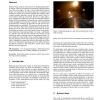Free Online Productivity Tools
i2Speak
i2Symbol
i2OCR
iTex2Img
iWeb2Print
iWeb2Shot
i2Type
iPdf2Split
iPdf2Merge
i2Bopomofo
i2Arabic
i2Style
i2Image
i2PDF
iLatex2Rtf
Sci2ools
APGV
2006
ACM
2006
ACM
Efficient selective rendering of participating media
Realistic image synthesis is the process of computing photorealistic images which are perceptually and measurably indistinguishable from real-world images. In order to obtain high fidelity rendered images it is required that the physical processes of materials and the behavior of light are accurately modelled and simulated. Most computer graphics algorithms assume that light passes freely between surfaces within an environment. However, in many applications, ranging from evaluation of exit signs in smoke filled rooms to design of efficient headlamps for foggy driving, realistic modelling of light propagation and scattering is required. The computational requirements for calculating the interaction of light with such participating media are substantial. This process can take many minutes or even hours. Many times rendering efforts are spent on computing parts of the scene that will not be perceived by the viewer. In this paper we present a novel perceptual strategy for physicallybased ...
APGV 2006 | Computer Graphics | Fidelity Rendered Images | Graphics Algorithms Assume | Visualization |
| Added | 20 Aug 2010 |
| Updated | 20 Aug 2010 |
| Type | Conference |
| Year | 2006 |
| Where | APGV |
| Authors | Oscar Anson, Veronica Sundstedt, Diego Gutierrez, Alan Chalmers |
Comments (0)

